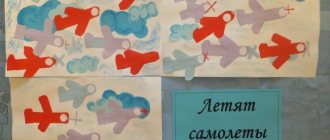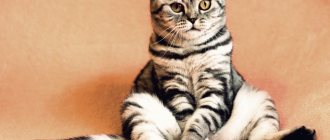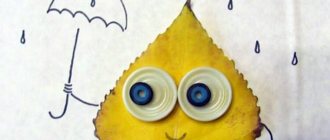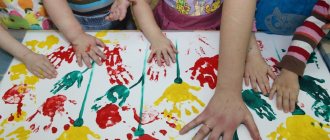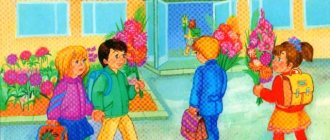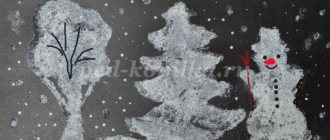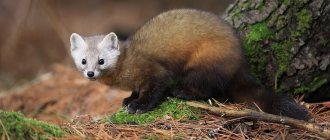Scheme for drawing up lesson notes
The lesson for children lasts 15 minutes. This time is distributed between three stages of mastering the topic:
- introductory stage - up to 3 minutes, aimed at motivating the children;
- the main stage - up to 10 minutes, devoted to a description of the work procedure, demonstration of drawing samples and the drawing process itself, which is preceded by finger exercises and/or physical education;
- the final stage - up to 2 minutes, during which the teacher praises and thanks all the kids for their work.
Table: Cheryapkina L. Summary of a drawing lesson on the topic “Balloons” in the second junior group (fragments)
| Stage | The essence |
| Introductory | The teacher tells the children that he has a gift for them and asks them to guess the riddle: I’m in a hurry for the holiday, I’m holding them by a thread: Red, yellow, blue - They float overhead, There’s nothing better for the kids than the airy ones. — Balloons (helps if children find it difficult to answer, shows a ball)…> |
| <… The teacher invites the children to play with the ball. Physical exercise: Children stand in a circle and hold hands. The adult slowly, melodiously pronounces the words, stepping back: “Inflate my balloon!” “Blow up big...” Everyone stops, holding hands and forming a large circle. The teacher continues: “Stay like that and don’t burst... bang!” - Let's inflate again! - Repeats the words of the game. The ball loves to be thrown up and caught, the ball wants to lie down, the ball can jump (children perform a variety of movements). | |
| Basic | Educator: - Do you like playing with the ball? Let's draw a lot of balls. — Kids love paints and pencils. We will use them to draw What? Can you guess? (ball) - Guys, today we will draw colored balls. You have multi-colored strings drawn on your leaves. Let’s “tie” a red ball to the red thread, a blue ball to the blue thread, a yellow ball to the yellow thread, and a green ball to the green thread. |
| Finger gymnastics | |
| The teacher shows the children how to hold the brush correctly: with three fingers, just above the iron tip, making sure that the children sit straight. First, children perform circular movements in the air, then carefully dip the brush first into water, then into paint. Excess paint is squeezed out on the edge of the jar. The brush is washed from paint and wiped with a napkin. | |
| Final | The teacher puts all the children's drawings on display, analyzes the children's work, praises the children, and, if necessary, helps a child who has difficulty completing a task. |
| Quote from: https://www.maam.ru/detskijsad/konspekt-zanjatija-po-risovaniyu-vo-vtoroi-mladshei-grupe-konspekt-nod-vozdushnye-shary-dlja-detei-2-ml-gr.html | |
Video: drawing lesson on the theme “Chicken” in the second junior group
Drawing on animalistic themes with younger preschoolers opens up new facets of their ideas about the world around them, expands the experience of perceiving the shapes, sizes of objects, as well as shades of colors. Practicing this type of art activity also helps to reveal the creative abilities of little pupils, teaches them to work with different materials for drawing, which is an important stage in the formation of experimental research activities. It also fosters a respectful and caring attitude towards animals and nature in general.
Summary of GCD in the 2nd junior group: Wild animals
GCD in the second junior group of kindergarten
Objectives: Educational:
To consolidate children's knowledge about wild animals, their appearance, and the peculiarities of their habits.
Fix the names of the cubs. Specify the name of the dwelling. Consolidate knowledge about basic geometric shapes (circle, square, triangle); about the primary colors (red, blue, yellow, green) and shade - gray. Developmental:
Develop coherent dialogical speech, the ability to coordinate different parts of speech.
Develop attention, memory, thinking. Develop children's creative abilities; Ability to work neatly and cleanly with paints. Educational:
Foster love for the world around us;
Feeling of compassion, desire to help; Cultivate neatness and cleanliness. Equipment:
“Forest” decoration, supplies of squirrels and mushrooms. Slideshow on the projector “Inhabitants of the Forest” For each child, a landscape sheet with the image of a white hare, gray gouache paints, cotton swabs, napkins.
Progress of activities
V.: What a good day today, guests have come to us, let's say hello the way we know how: “Hello, palms - clap, clap, clap. Hello, legs - top, top, top. Hello, cheeks - splash, splash, splash. Round cheeks - splash, splash, splash. Hello, sponges - smack, smack, smack. Hello, teeth - click, click, click. Hello, my nose is bi, bi, bi. Hello, dear guests - hello. Mail: “Come urgently, help urgently! Miracles happen, we cannot divide the forest. The wizard scared us, he bewitched us all. We have forgotten who we are, what we should drink and what we should eat. Help us out, come and make peace between us urgently!” Forest inhabitants. Q: What are the names of the animals that live in the forest? (wild) Q: What wild animals do you know? Q: Why are they called wild? V.: some wizard bewitched all the animals, now they don’t know who they are, what they should eat, where to live, and most importantly, they don’t recognize their cubs. They ask us for help, shall we help? Q: But what can you use to go into the forest? Let's remember what types of transport we know. V.: They travel long distances by plane, the train travels on rails, they sail on the sea by ship, few people can fit in the car. Q: Are there many of us or few? Q: There are a lot of us, and the forest is not far, what can we all ride at the same time? V.: To go by bus, you need to buy tickets and sit in the place where the same figure of the same color is depicted (geometric shapes are glued to the chairs: a square, a circle and a triangle in red, yellow, blue and green colors) An inspector comes in and checks randomly tickets. The song “Bus” by V. sounds: it seems that we have arrived, listen to how the birds sing, how it smells in the forest. It’s very beautiful here, but I don’t see a single forest dweller. The animals are probably very confused, because they have forgotten who they are. 1 slide. Bear.
- who is this? -Tell me, children, what kind of bear is it? (big, brown,
kind, he has powerful paws, small ears) - what is the name of the cub? -What does he like to eat? - but in winter there is no honey and berries, what does the bear do? -Where does he sleep? 2 slide. Bear in a den.
V.: Oh, look, under the bush, under the bush there is Someone with a red tail. Who do you think it is? , 3rd slide Fox.
Q: Look at the fox and tell me what it is like. The fox is red, beautiful, cunning. She has a fluffy, long tail. She is often called plutovka, which means a deceiver. The fox does not change its coat; it is red both in summer and winter. -What is the name of the cub? 4 slide. Nora.
There is a fox's house under the bush. What is the name of the fox's house? V.: The entrance to the hole is narrow, long, and inside the hole is spacious and comfortable. Q: Who knows why the fox needs such a fluffy tail? (cover tracks) V.: let’s show together how a fox walks and covers its tracks. Physical exercise. The fox walked through the forest, made song calls, the fox tore the stripes, the fox wove bast shoes, walked near the Christmas tree, and what did you find on the Christmas tree? Mushrooms? Q: Do mushrooms grow on the Christmas tree? Q: What grows on the Christmas tree? (cones and needles)Where do mushrooms grow? (on the ground) V.: then whose mushrooms are these? (squirrel reserves) Where is the squirrel itself? 5 slide. Squirrel
V.: here she looks at us and asks for help, because she has forgotten who she is. Come on, guys, we'll tell you about her. What kind of coat does a squirrel have? (red, fluffy) Ears, tail? What is a baby squirrel called? (little squirrel) What is the name of her house? (hollow) 6 slide. Squirrel in a hollow.
V.: squirrels make themselves a house high in a tree. Let's show together how high it is. (We stand on our toes) Q: Why do you think the squirrel’s house is so high? (so that other animals cannot get to her or her supplies) V.: All animals have their own houses: the bear has a den, the fox has a hole, the squirrel has a hollow, but where does the hare live? What kind of house does he have? V.: The bunny doesn’t have a house, he slept under a bush and ran away, so he runs fast because there is nowhere to hide. Slide 7 The hare is white.
V.: Here is the bunny, let's look at it together. What kind of ears, tail, fur coat does he have? V.: The hare is a real fashionista: in winter he wears a white fur coat, and in summer he wears a gray one. Why do you think? (to make it easier to hide) Oh, trouble! It’s already spring, but the hare still hasn’t changed his coat, we need help. Painting a white hare gray (using the “poking” method with cotton swabs) 8 slide . The hare is gray.
V.: Look, the hare is already gray, we helped him. Great job guys, well done! Oh, he's already galloped away. Slide 9 Wolf
V.: Another resident showed up. Gray, scary and toothy. Caused a commotion. All the animals ran away. Scared the animals... V.: tell me what he is like? Slide 11 Lair.
V.: The wolf also has a home, look at what it is like. His home is called a lair. Sad music sounds and a wizard appears. V.: wizard, what happened, why are you so sad? Wizard: Yesterday I accidentally bewitched all the animals in the forest. I can’t cast the spell back - I forgot the words. V.: Don’t worry, wizard, we have already helped all the animals. We reminded them who they are, where they live and what they like to eat. V.: Guys, let's tell the wizard what animals we helped. Wizard: Thank you very much, you helped me out so much. Who are you and where did you come from? (from kindergarten) Wizard: what are you doing there? Show how you can dance. Dance “Stamp, my foot” Wizard: my time has come to please you. Close your eyes. The wizard says special words and a huge candy appears. Q: How can we share one candy among everyone? The wizard once again asks you to close your eyes, casts a spell, and many small ones appear from the large candy. The wizard thanks for the help and leaves. V.: oh, guys, it’s already very late, it’s time to go back. The bus ride will be long, so we will return to the group by plane. V.: they started the engines, spread their wings and flew.
We recommend watching:
Summary of GCD for children of the 2nd junior group on the topic: Winter Summary of GCD cognition using ICT in the 2nd junior group. Journey to the autumn forest Lesson notes. Walk through the forest. Senior group About animal houses for preschoolers
Similar articles:
Conversation about the hare for older preschoolers
What can you tell children about a hedgehog?
A story about a squirrel for 1st grade children on the world around them
What can you tell children about the fox?
Conversation about the wolf. Senior - preparatory group
